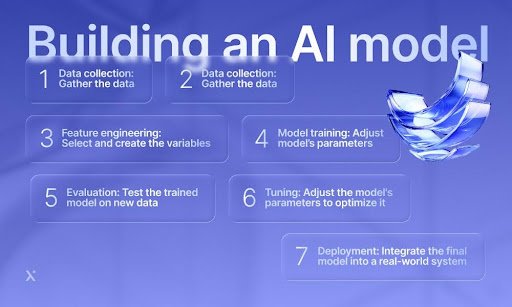Embarking on the journey of building an AI model for enterprise use can feel like preparing for a lunar mission. It sounds incredibly complex, futuristic, and expensive. While the process is indeed detailed, it’s far from impossible. The secret isn’t in hiring a legion of mad scientists, but in adopting a disciplined, step-by-step approach that transforms a vague business goal into a tangible, intelligent system. It’s a structured process that moves from the high-level ‘what if’ to the nitty-gritty of code and data. This playbook breaks down that journey, showing how a clear strategy is the most critical component for turning your AI ambitions into a reality that delivers real business value.
Step 1: Start with a question, not a technology
The most common mistake businesses make is starting with a fascination for AI itself. They want “an AI,” but they haven’t clearly defined what it will do. This is a recipe for a costly science project with no real payoff. The correct starting point is always a specific, well-defined business problem.
- What is our goal? Are we trying to reduce customer churn, predict equipment failure, or automate the detection of fraudulent transactions? The goal must be measurable.
- What decision will the AI support? An AI model doesn’t just produce an answer, it drives an action. What will people do differently with the model’s prediction in hand?
- What data do we have? You cannot build an AI model without data. An honest assessment of your data assets is crucial. Do you have historical data related to the problem you’re trying to solve? Is it accessible, and is it of sufficient quality?
Answering these questions turns a vague idea into a concrete project scope. It’s the foundation upon which everything else is built.
Step 2: The unsung hero of AI is your data
Everyone loves to talk about fancy algorithms and neural networks, but the truth is that the success of any AI project hinges on the quality of its data. This is often the most time-consuming and challenging phase, but skipping corners here will guarantee failure later. The process is meticulous and has several stages.
- Data gathering: This involves pulling data from all relevant sources, which could be your company’s databases, CRM systems, sensor logs, or even external datasets.
- Data cleaning: Real-world data is messy. It has missing values, incorrect entries, and inconsistencies. This stage involves fixing these errors, removing duplicates, and handling outliers to create a clean, reliable dataset.
- Data preparation: This is where you transform your clean data into a format the AI model can understand. It might involve converting text to numbers, normalizing values so they are on a similar scale, and engineering new features that might give the model better signals to learn from.
Think of your data as the ingredients for a gourmet meal. No matter how skilled the chef, you can’t make a masterpiece with spoiled or low-quality ingredients.
Step 3: Training and refining your model
With a high-quality dataset ready, you can finally start training your AI model. This is an iterative process of experimentation and refinement.
- Model selection: There isn’t one “best” AI model. The right choice, whether it’s a simpler model like a decision tree or a complex neural network, depends entirely on the problem you defined in step one. Often, the best approach is to start simple.
- Training: This is the process of feeding your prepared data to the selected algorithm. The model analyzes this data to find patterns and learn the relationships between the input features and the desired outcome.
- Evaluation: Once the model is trained, you need to test how well it performs on new, unseen data. This is where you measure its accuracy and effectiveness against the business goal you initially set.
- Tuning: Based on the evaluation, you’ll likely go back and adjust the model’s parameters, or even try a different algorithm altogether, to improve its performance. This loop of training, evaluating, and tuning continues until the model meets the required standard.
This phase is where a partnership with a skilled AI development company in the United States can be invaluable, as they have the expertise to navigate the vast landscape of available models and find the optimal fit for your specific business context.
Building a successful AI model is less about a single “eureka” moment and more about a methodical process of refinement. It’s a journey from a clear business question, through a rigorous data preparation phase, to an iterative cycle of training and improvement. By following this playbook, any enterprise can demystify the process and build powerful AI solutions that solve real-world problems.

